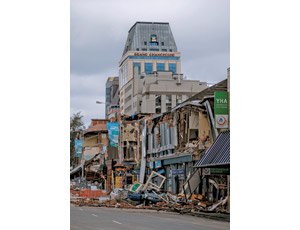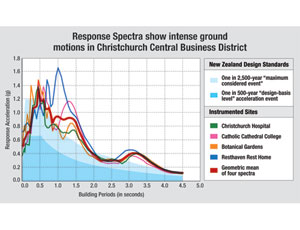A week after the devastating shallow earthquake that struck Christchurch, New Zealand, on Feb. 22, structural engineers are surprised and relieved that damage to modern engineered buildings was not even more widespread. Recordings at several instrumented sites indicated that ground motion exceeded the maximum considered event. The MCE has a one in 2,500 chance of happening in any given year.
The magnitude-6.3 Canterbury quake, centered some 10 kilometers from downtown Christchurch and only 5 km deep, caused significantly more damage than the magnitude-7.1 quake that struck the area on Sept. 4, 2010.
“The scenes of devastation are horrendous, but as the intensity of shaking has now been suggested to have been at the maximum-considered-event level, that should not be surprising,” says John Hare, a local structural engineer with Holmes Consulting Group and president of New Zealand’s Structural Engineering Society.
As of March 1, the official death toll was 155, out of more than 240 who were missing. Insurance losses are estimated at $12 billion, compared to the $3.8 billion in September’s Darfield quake. There are reports that one-fifth to one-third of the buildings will be razed in the heart of the mostly low-rise city. Many of the structures are vulnerable, older unreinforced-masonry construction.
Structural engineers report that, under the circumstances, modern buildings performed better than expected, especially some two- to four-story, reinforced-masonry block buildings, which show minor damage.
New Zealand’s seismic building code is considered on par with the U.S. life-safety code. “This is not a failing of [New Zealand’s] codes or design. It is recognition that although the magnitude of the earthquake was not high, it’s proximity and depth were such that its impact was tremendous, and continued aftershocks compound this,” according to Hare.
The shaking recorded at several central district sites was generally stronger than the MCE, which is 1.8 times bigger than the design-basis event (see graph). Buildings are designed to meet the design-basis level, a minimum for life safety and collapse prevention in a 500-year quake, as well as added safety factors. “We would expect even new buildings, under more than the MCE, could collapse,” says Gregory A. MacRae, an associate professor in the Dept. of Civil and Natural Resources Engineering at the University of Canterbury, Christchurch.
In addition to shaking-induced damage, much of the destruction was caused by soil liquefaction. The eastern suburbs have significantly more liquefaction than downtown. As of Feb. 28, crews had collected 120,000 tonnes of silt. The estimated total amount to be removed is more than 200,000 tonnes. In the Sept. 4 quake, only 30,000 tonnes were removed.
Because the buildings performed well under the strong shaking, MacRae does not expect the codes to change too much. But he believes the public is likely to resist the notion of rebuilding anything but a low-rise city.
By March 1, crews had stabilized the 26-story Hotel Grand Chancellor, which was still standing after dropping about one meter at one corner. Damage to the concrete-framed hotel, which was considered on the verge of collapse, had prevented investigators from checking other buildings within 90 m of the perimeter. Surveys conducted since Feb. 23 established no subsequent movement in the structure.
Urban search-and-rescue engineers and others carried out a detailed evaluation of the structure, which has precast concrete cladding.
The 85-m-tall building—first constructed in 1975 as an office building and engineered by Grant Wilson, with additions in 1986 and 1995—tilted because critical supports failed in the southeast part of the building at the ground level, where cantilevered girders that create an overhang corner failed. Three columns on level 12 were damaged as well.
“Ground accelerations had a vertical component of up to 1.8 g,” according to Roberto T. Leon, a professor of engineering at the Georgia Institute of Technology, Atlanta. Leon, president of the American Society of Civil Engineers Structural Engineering Institute, arrived in Christchurch on Feb. 15 for a three-month teaching fellowship.
The first stabilization phase focused on the damaged ground-floor wall, with concrete cast into boxed formwork on either side of the wall. Crews then sprayed concrete on both sides of the wall to strengthen it further. Next, crews will wrap steel jacketing around the damaged columns under level 12 and pump concrete between the jacketing and the columns.
In the city of 348,000 inhabitants, older unreinforced-masonry and stone buildings were hit hardest in the quake, deemed an aftershock of the Sept. 4 temblor. Several recently seismically retrofitted buildings collapsed, including the Christchurch Cathedral, says Amir Gilani, a senior associate with Los Angeles-based structural engineer Miyamoto International. Gilani connected with local engineer Cardno to help perform damage assessments. “Clearly, the retrofit criteria or methods failed,” says Gilani.
After the Sept. 4 quake, Christchurch instituted a seismic retrofit code, which requires that the strength of the unreinforced-masonry buildings be elevated to 33% of the design-level strength in the New Zealand Building Code. After the Feb. 22 quake, the city is considering requiring that unreinforced-masonry buildings be elevated to 67% of the design level. Without retrofits, the strength of the older buildings is about one-tenth of the design-level strength, says MacRae.
The deadliest building failure occurred at the Canterbury Television building. More than 125 people are thought to have been trapped inside.
The seismic provisions of the New Zealand code were updated as recently as 1992, after an extensive revision in the mid-1980s. Post-quake discussions are likely to center on code changes, quite possibly beyond the New Zealand Building Code, Hare says. “The world must learn from this.”




Post a comment to this article
Report Abusive Comment